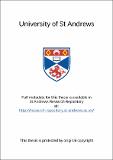Files in this item
The activation of adenovirus type 2 protease and the function of the activating peptide
Item metadata
| dc.contributor.advisor | Kemp, Graham | en |
| dc.contributor.author | Pollard, Brett David | en |
| dc.coverage.spatial | 168p | en |
| dc.date.accessioned | 2021-04-08T08:59:28Z | |
| dc.date.available | 2021-04-08T08:59:28Z | |
| dc.date.issued | 2001 | |
| dc.identifier.uri | https://hdl.handle.net/10023/21928 | |
| dc.description.abstract | Some 42 serotypes of Adenovirus are infectious to Humans. To be able to prevent infection using vaccination would be difficult to say the least, since one might have to administer as many as 42 vaccines, one for each serotype. However, if one could produce an antiviral agent specific to an event within the virus's life cycle to prevent the infectiousness one agent could potentially be effective to all serotypes. One such target is the 23 kD protease enzyme responsible primarily for maturation cleavages of structural proteins comprising the viral capsid and the cytoskeletal proteins to escape the cell. The work described here is aimed at understanding more about the role of the peptide responsible for the activation of the protease and determining whether the unusual activation mechanism of this protease is a suitable target for the therapeutic inhibition. Another aim of the study was to attempt to develop an in vivo protease inhibitor assay to complement in vitro activation studies which required the development of a single step purification protocol for the protease. However, attempts to stably integrate the protease and pVI in HeLa and 293 cell lines were not successful due to the toxicity of the basal level of expression and the cocktail of antibiotics required for the selection for integration. Use of transient transfections illustrated that the protease could cleave cytokeratin in vivo in the absence of activating peptide, and suggested that the protease was still toxic to the cells. Studies revealed that the protease from the human serotype 2 could be activated by the peptide from the avian Adenovirus responsible for Egg Drop Syndrome (EDS virus). Since the sequence of the EDS peptide and protease are the most distinct in evolutionary terms from the human type 2, such a cross-activation suggests that any interference with the activation system could be effective across the serotype range. Results obtained here show that the length of the peptide is critical, and contrary to previous reports no evidence was obtained to support the suggestion that the peptide VEGGS is capable of activating the protease. Mutation studies on the contiguous stretch of 4 basic residues within the activating peptide sequence suggested that this does not have a critical role in activation. However, parallel studies showed that this motif could act as a nuclear localisation signal as it is capable of targeting a chimeric protein to the nucleus in a model system. Finally a rapid assay was developed for assessing the binding affinity of peptides to the protease, and results obtained with this suggested variants which are worthy of further study in the search for a possible inhibitor. | en |
| dc.language.iso | en | en |
| dc.publisher | University of St Andrews | en |
| dc.subject.lcc | QP609.P7P7 | |
| dc.subject.lcsh | Proteinase | en |
| dc.title | The activation of adenovirus type 2 protease and the function of the activating peptide | en |
| dc.type | Thesis | en |
| dc.type.qualificationlevel | Doctoral | en |
| dc.type.qualificationname | PhD Doctor of Philosopy | en |
| dc.publisher.institution | The University of St Andrews | en |
This item appears in the following Collection(s)
Items in the St Andrews Research Repository are protected by copyright, with all rights reserved, unless otherwise indicated.

